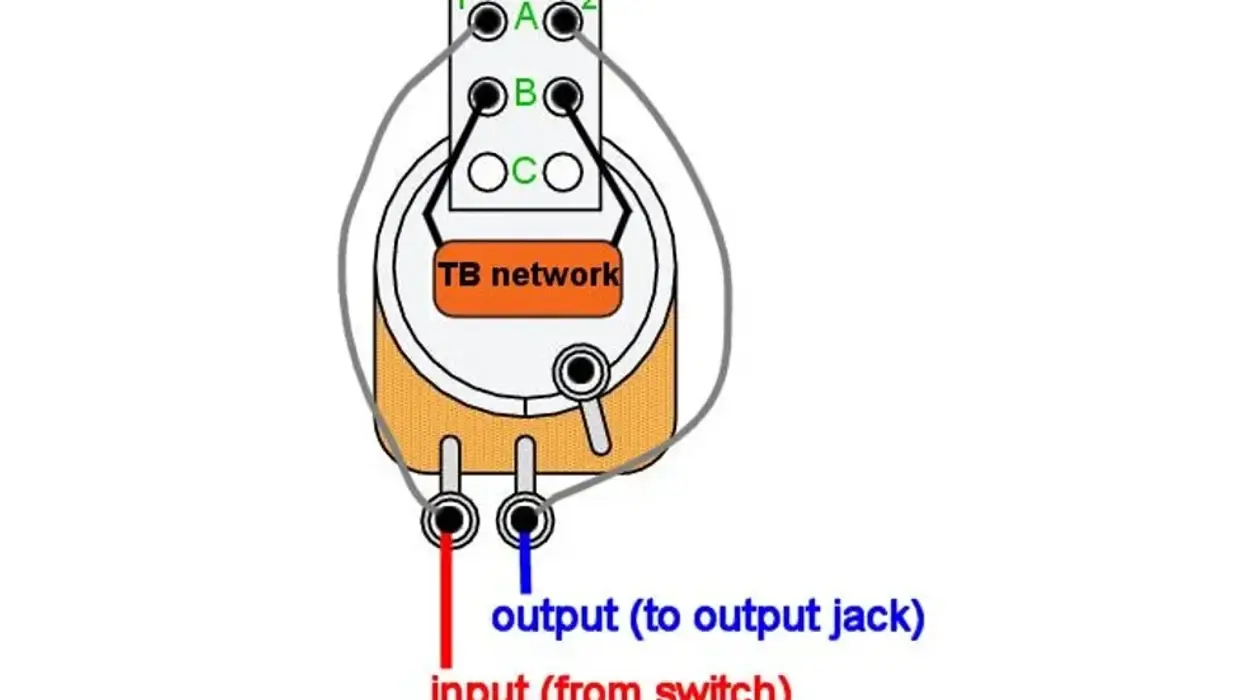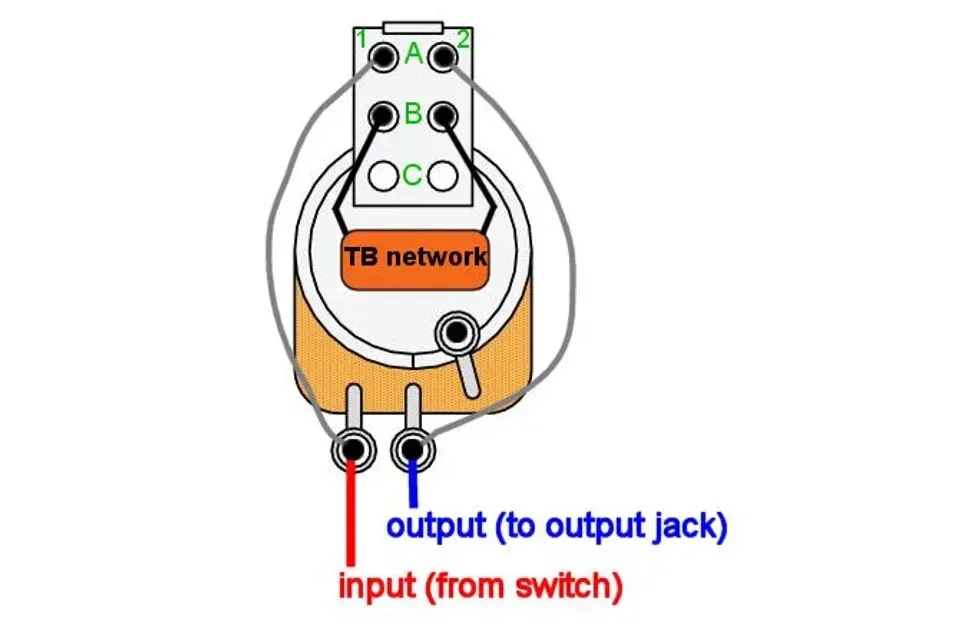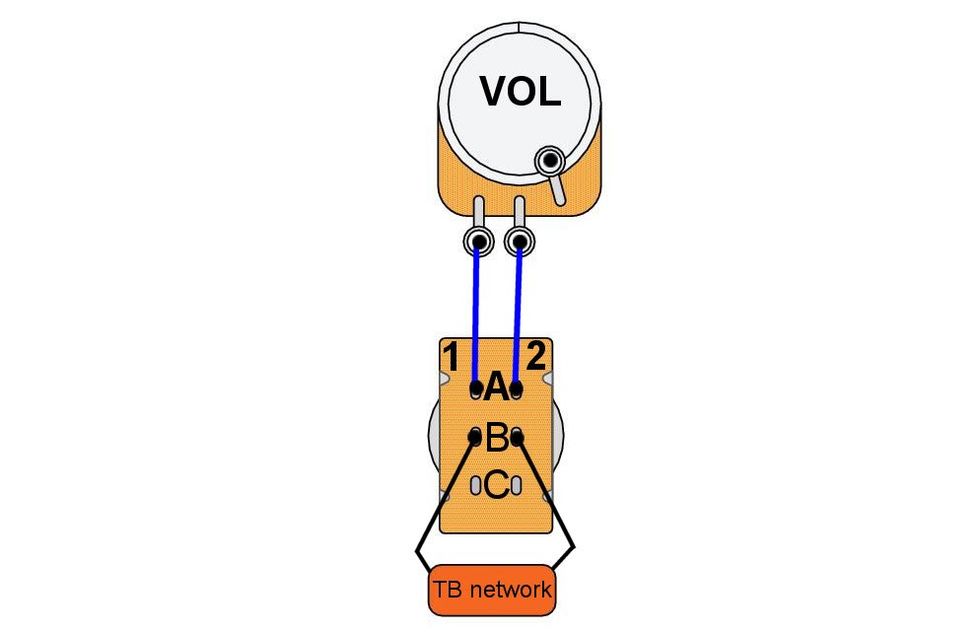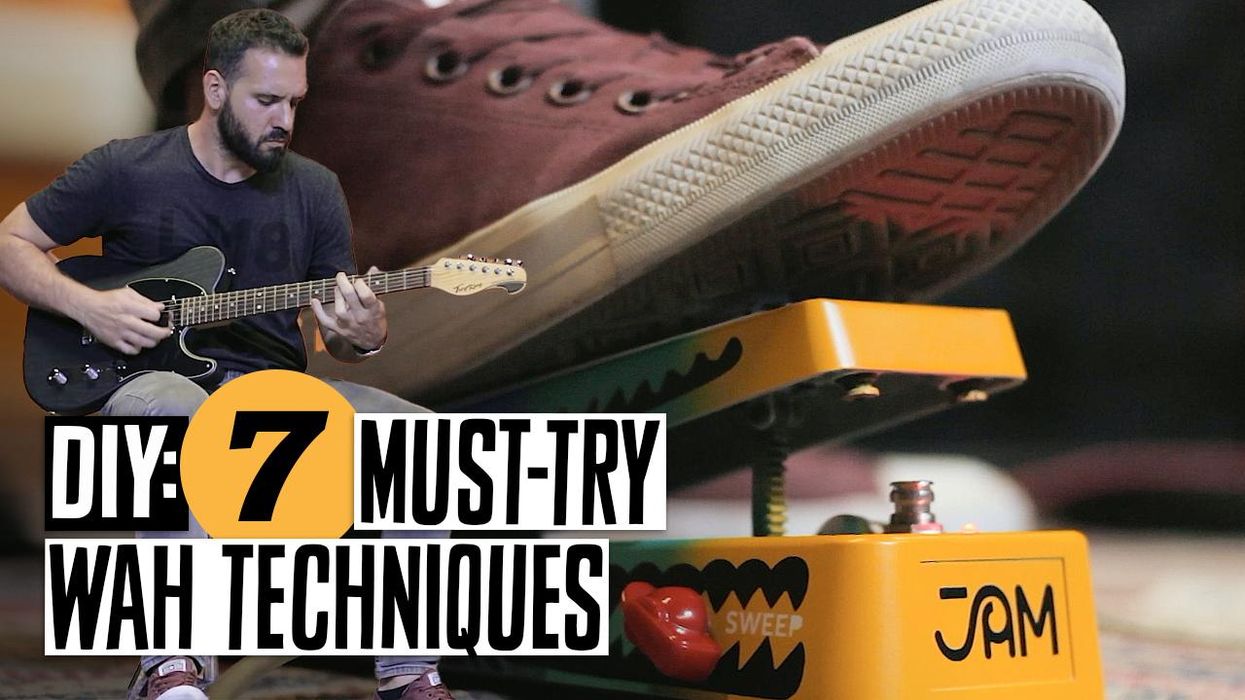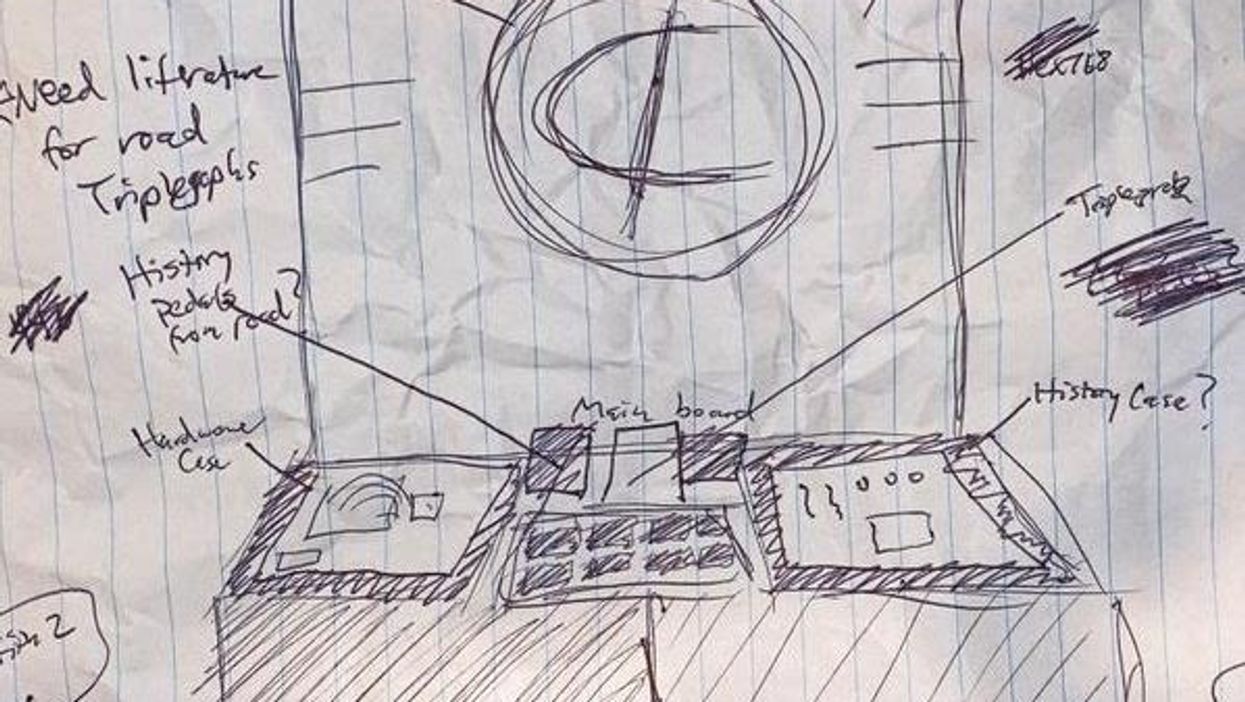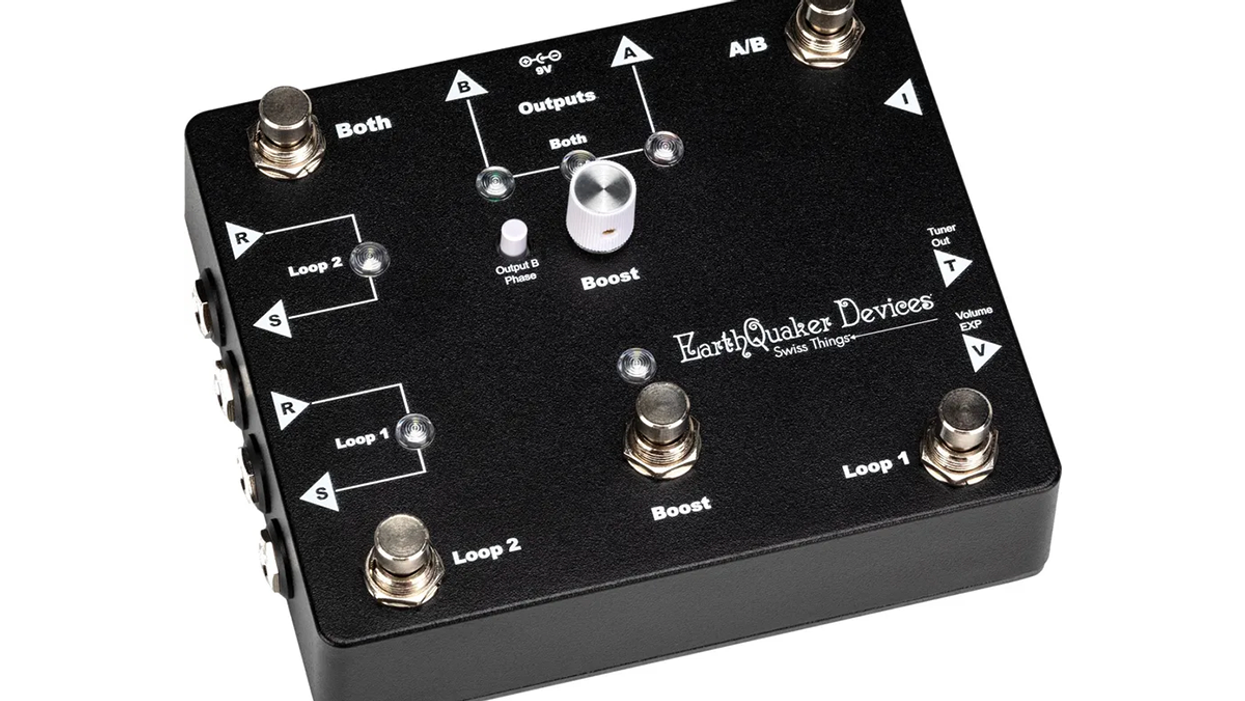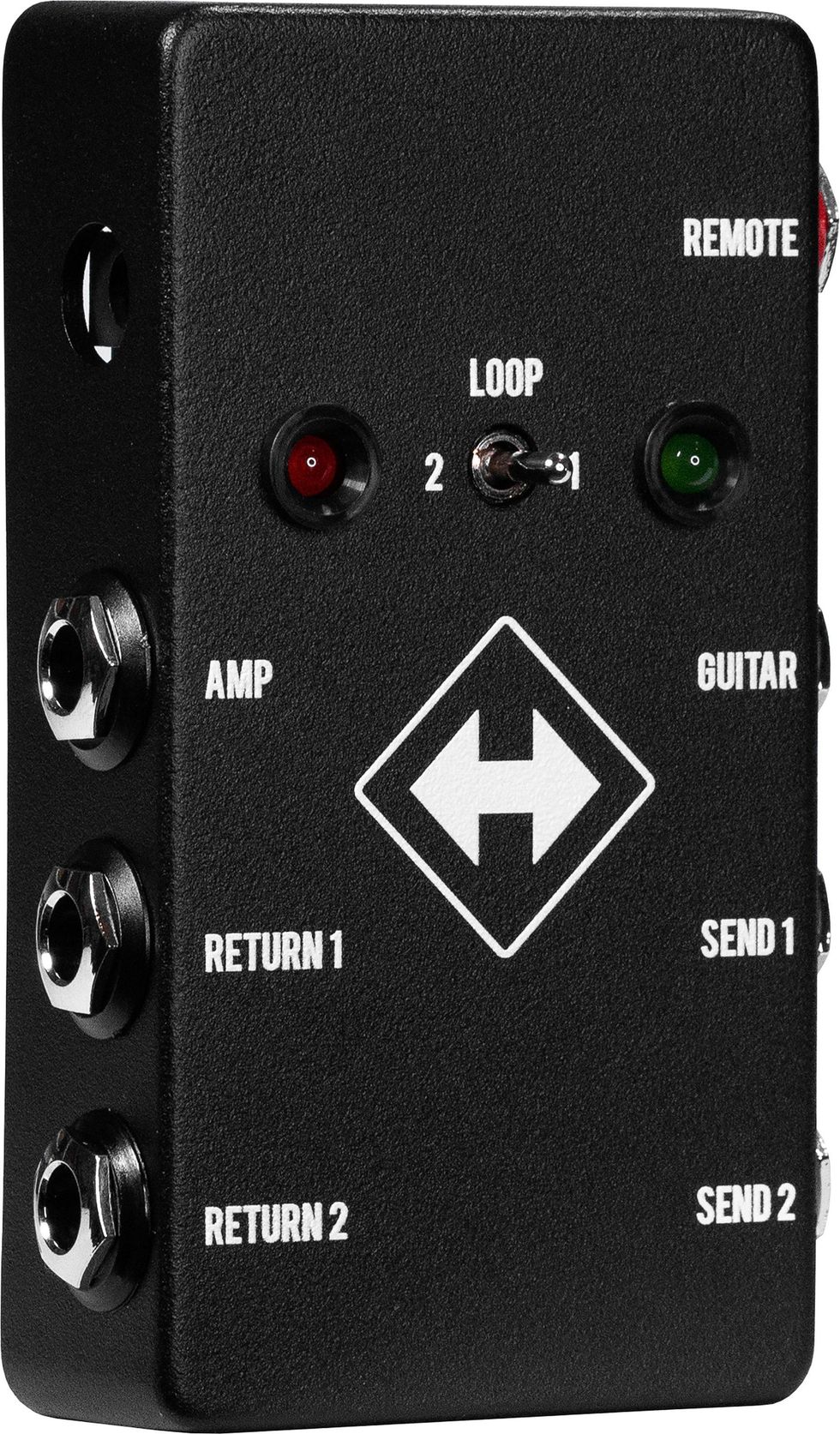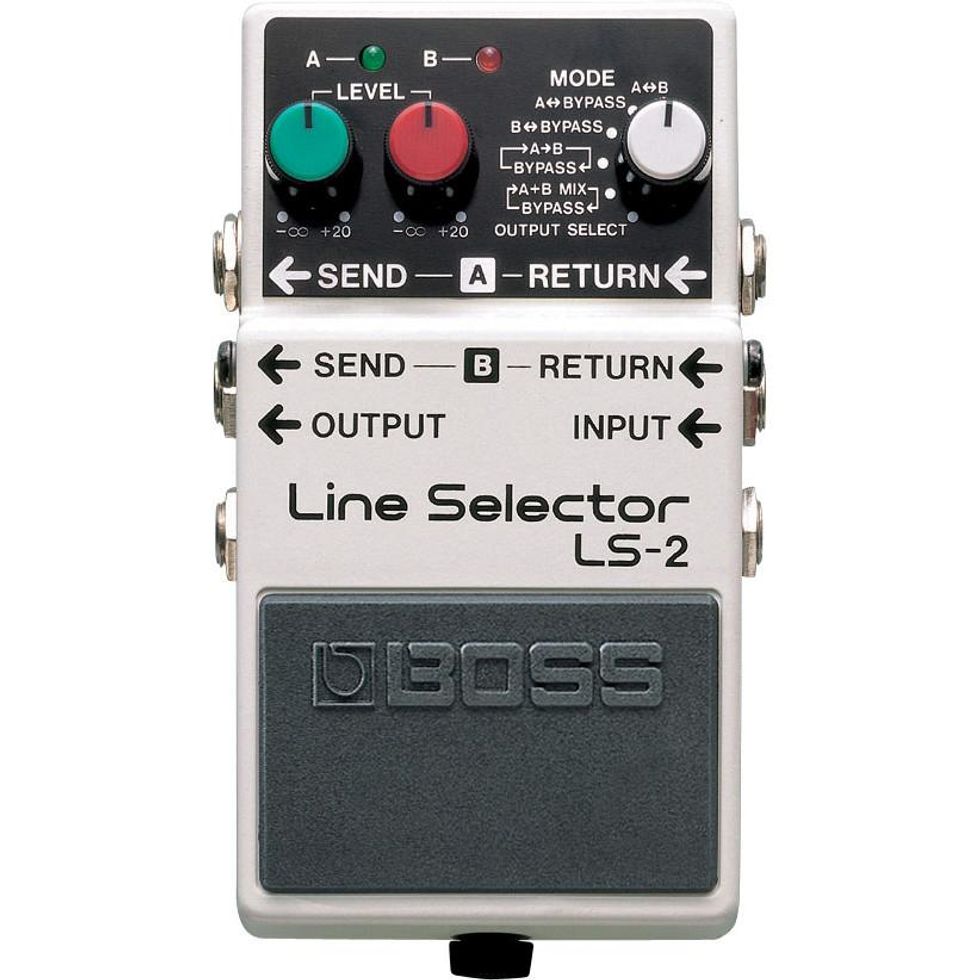It’s that time of year, when Premier Guitar readers get the chance to show off their pedalboards and share how they approach these tools to unlock their sound. There’s no wrong way to wire up your effects—as we know, the options are virtually endless. But that’s the fun of it! Read on to see a completely blacked-out pedalboard created by a pro guitar tech, a repurposed Target dish-drying rack, a family tree of 12 (!!!) pedalboards, and much more. Some boards are painstakingly planned and arranged, and some are visually appealing. Whatever you like, stomp on!
Alec Palmer: Brand Loyalist
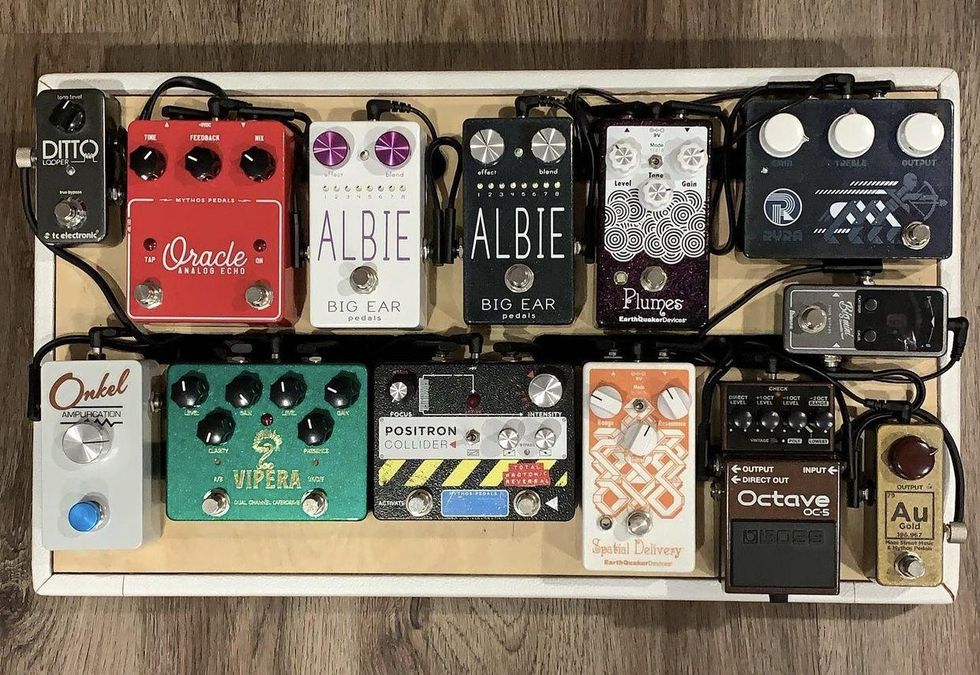
I use my board to practice and record from home, and I love jamming with a couple of my musician buddies every so often. I’d say my favorite pedals are the EarthQuaker Devices Plumes and the Big Ear Albie. I can get a ton of different effects out of the Albie, and the Plumes is the best overdrive I’ve ever played. I’m a bit of a brand loyalist. When I find a pedal I love, I tend to go back and buy more pedals from that specific company. Lately, that company has been Mythos Pedals!
Signal chain: Mythos Pedals Golden Fleece (Au79 Mass Street Music exclusive), Ibanez BigMini Tuner, Boss OC-5 Octave, EarthQuaker Devices Spatial Delivery, Mythos Pedals Positron Collider Fuzz, Mythos Pedals Wildwood Vipera, Onkel Amplification Stratoblaster, Ryra Klone, EarthQuaker Devices Plumes, Big Ear Pedals Albie (2), Mythos Pedals Oracle Analog Echo, and a TC Electronic Ditto Looper.
Brad Konick: Is It Humble, Though?
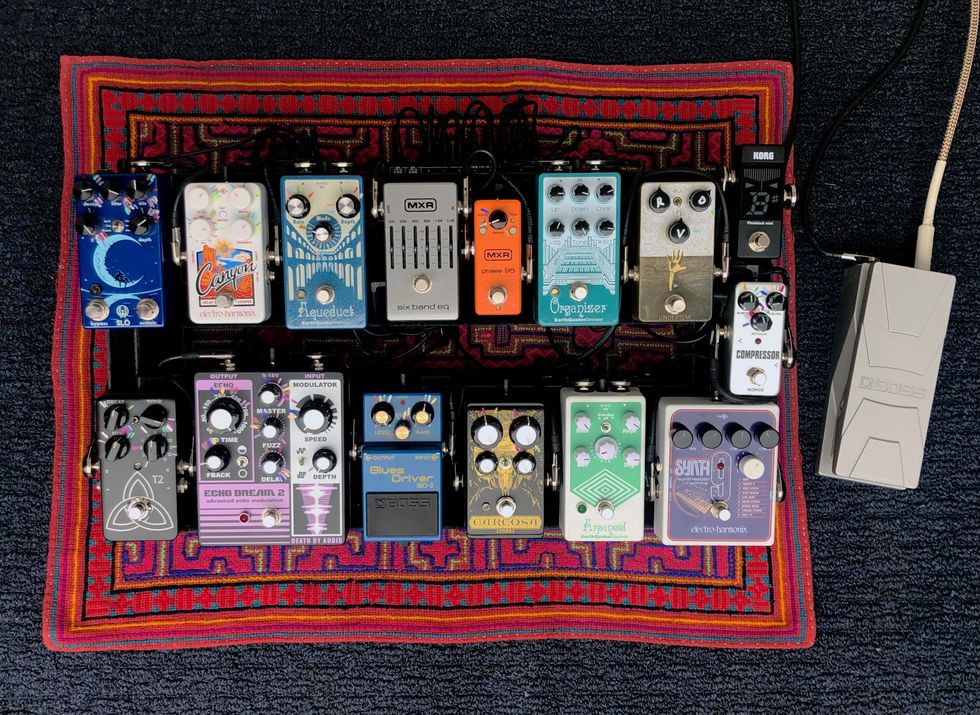
Here’s my humble pedalboard submission for your consideration. Each pedal is listed in order of the signal chain. I’m also including a photo of the electric guitar I use, which I made a few years ago. It’s a handbuilt custom solidbody, black walnut T-style electric guitar, with handcarved bas-relief and handmade steel inlay. Pickups are a Seymour Duncan Hot Rodded humbucker set: Jazz (neck) and JB (bridge). The guitar plugs first into the Boss volume pedal listed below.
Pedals - Signal Chain:
- Boss FV-30H Volume Pedal >
- Korg Pitchblack Mini Tuner >
- Kokko Mini Compressor >
- Electro-Harmonix Synth9>
- EarthQuaker Devices Arpanoid V2 Polyphonic Pitch Arpeggiator >
- DOD Carcosa Fuzz >
- Boss BD-2 Blues Driver>
- Death by Audio Echo Dream 2 Advanced Echo Modulation >
- TC Electronic T2 Reverb >
- Pedal Projects Undertow Tremolo >
- EarthQuaker Devices Organizer Polyphonic Organ Emulator >
- MXR Phase 95 >
- MXR Six Band EQ >
- EarthQuaker Devices Aqueduct >
- Electro-Harmonix Canyon Delay/Looper >
- Walrus Audio Slö Multi Texture Reverb >
- Roland JC-22 Jazz Chorus (amp)
Power and Cables:
- MXR M239 Mini Iso-Brick Power Supply
- Donner DP-2 Power Supply
- Snark 9-volt power adapters
- 1/4” Audioblast pancake patch cables (6", 8", 3')
- Fender tweed 1/4” TS 15' instrument cable
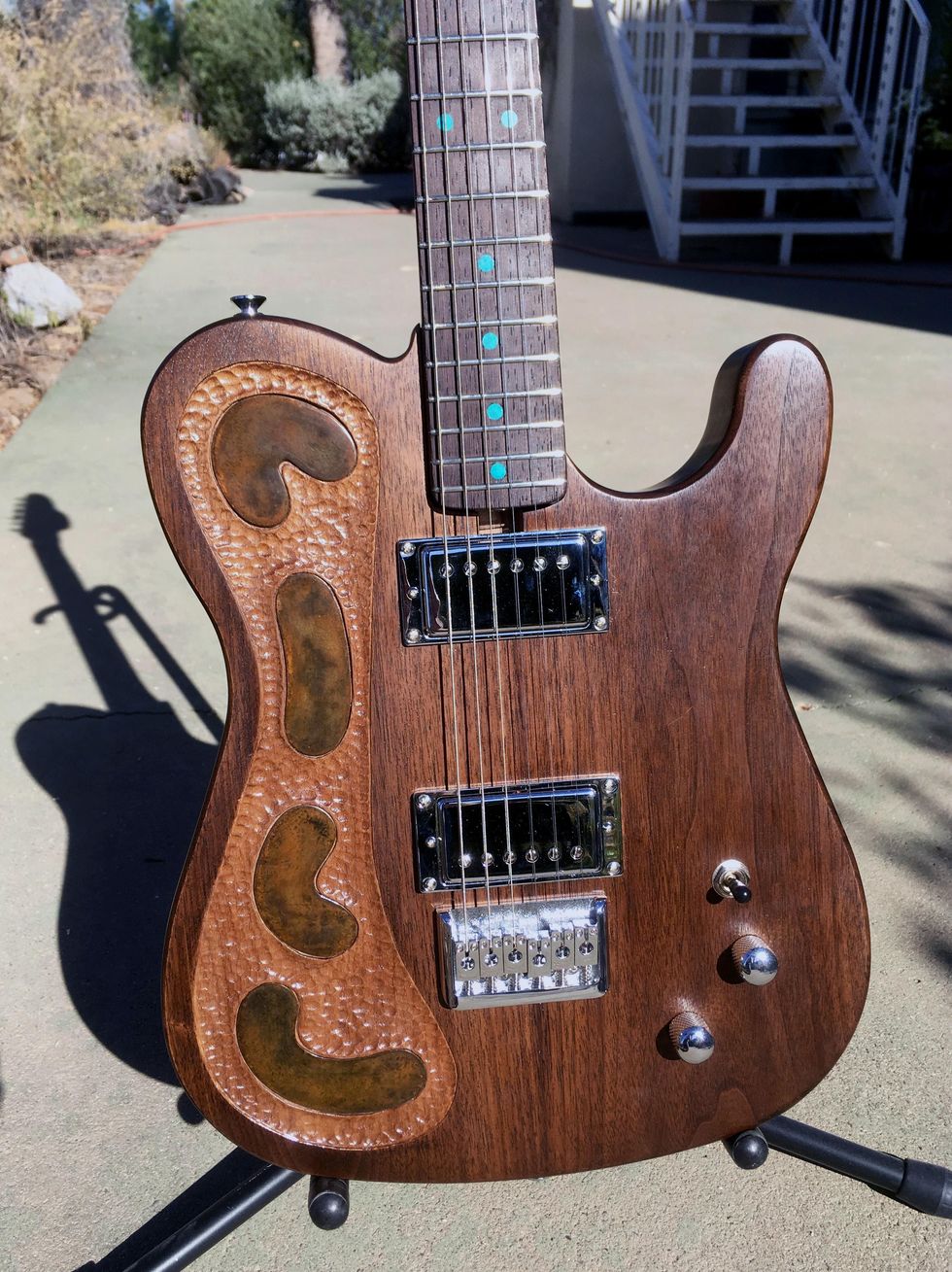
I’m also including a photo of the electric guitar I use, which I made a few years ago. It’s a handbuilt custom solidbody, black walnut T-style electric guitar, with handcarved bas-relief and handmade steel inlay. Pickups are a Seymour Duncan Hot Rodded humbucker set: Jazz (neck) and JB (bridge).
Chris Gibbs: Load In, Load Out
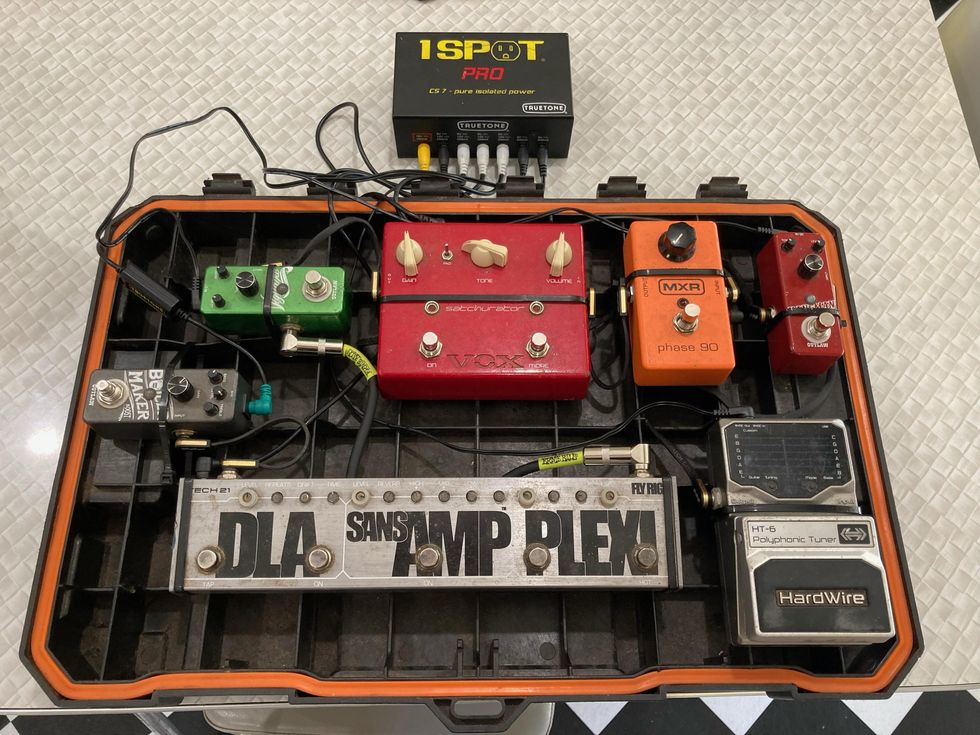
This is the pedalboard I use for gigs with my band, Triple Engine, in York, Western Australia. The board is actually the lid of a Craftright tool/accessory case.
When the gig is finished, I can pack leads, extra pedals, power supplies, and more into the case, flip the board so that it becomes a lid again, re-insert the removable hinge pins, and load out!
Here’s how it flows: DigiTech HardWire HT-6 Polyphonic Tuner > Outlaw Effects Hangman Overdrive > MXR Phase 90 >Vox Satchurator Distortion > Outlaw Effects Vigilante Chorus > Tech 21 Fly Rig 5 > Outlaw Effects Boilermaker Boost.Clint Roth: Vision Board
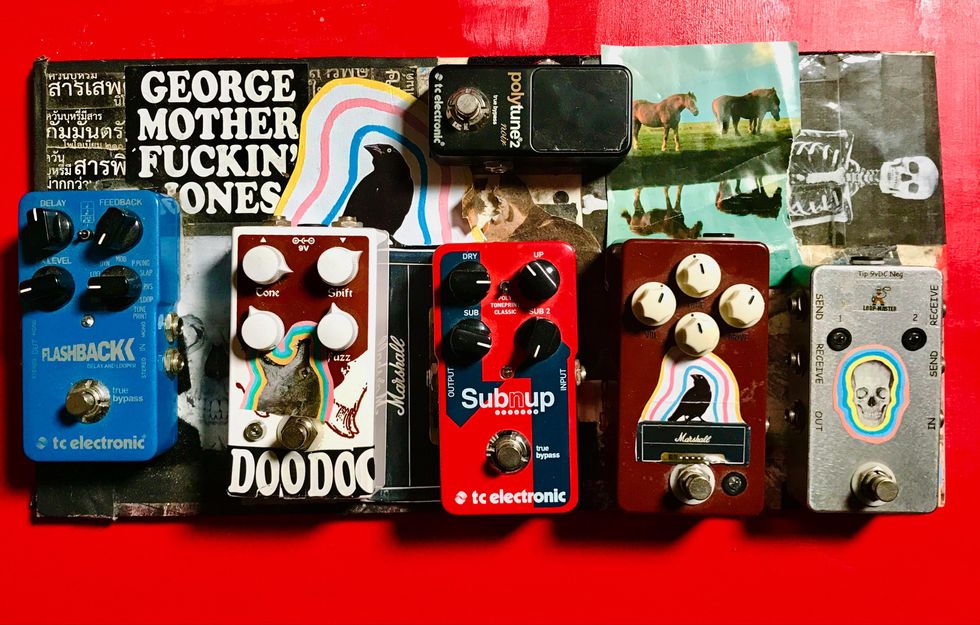
Hey PG,
Here’s my current small board I’m using for writing with my band, Big Jaw. I plug into a TC PolyTune 2 Noir that feeds a Loop-Master A/B Box. The “A” loop is my JHS Charlie Brown overdrive, and the “B” loop is my fuzz, which is an old EarthQuaker Devices Hoof fed by a TC Electronic Sub ’N’ Up Octaver. I usually use the octave and fuzz together so it’s helpful to have them on a loop like that so I can switch to both with one click. The output of the Loop-Master feeds my TC Electronic Flashback Delay, which is usually just giving me a little slapback. Thanks!
David Reaume: Bass and Bow
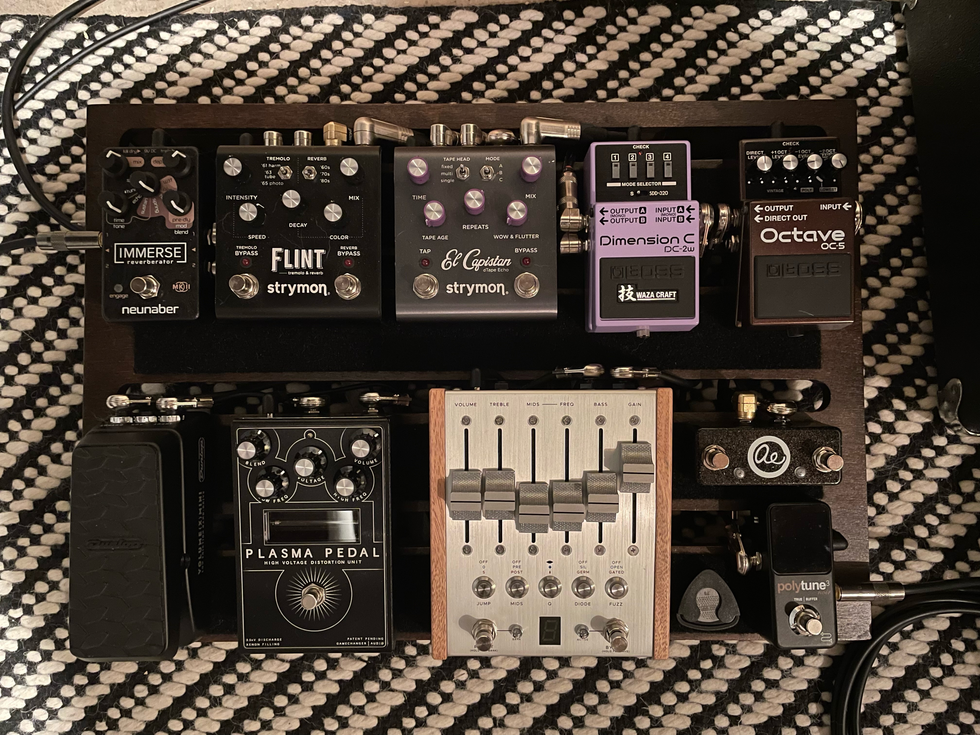
Here’s my bass board! I use it mostly for ambient music to create textures, but it covers a lot of territory as you can see. I use a cello bow frequently. Paired with the octave and additional reverb, it really makes for a convincing string section.
Signal Chain:
- TC Electronic PolyTune 3 >
- Boss OC-5 >
- Chase Bliss Audio Automatone Preamp MKII >
- Gamechanger Audio Plasma Pedal >
- Dunlop DVP4 Volume (X) Mini >
- Boss DC-2W Dimension C (split in stereo for the rest of the chain) >
- Strymon El Capistan dTape Echo >
- Strymon Flint Tremolo & Reverb >
- Neunaber Audio Immerse Reverberator MKII
All powered by a Strymon Zuma power supply on a custom board (made by yours truly) with custom-length Mogami patch cables. The Analog Endeavors Dual Favorite switch is for the Strymon pedals.
DeMatt Harkins: The Dishwasher
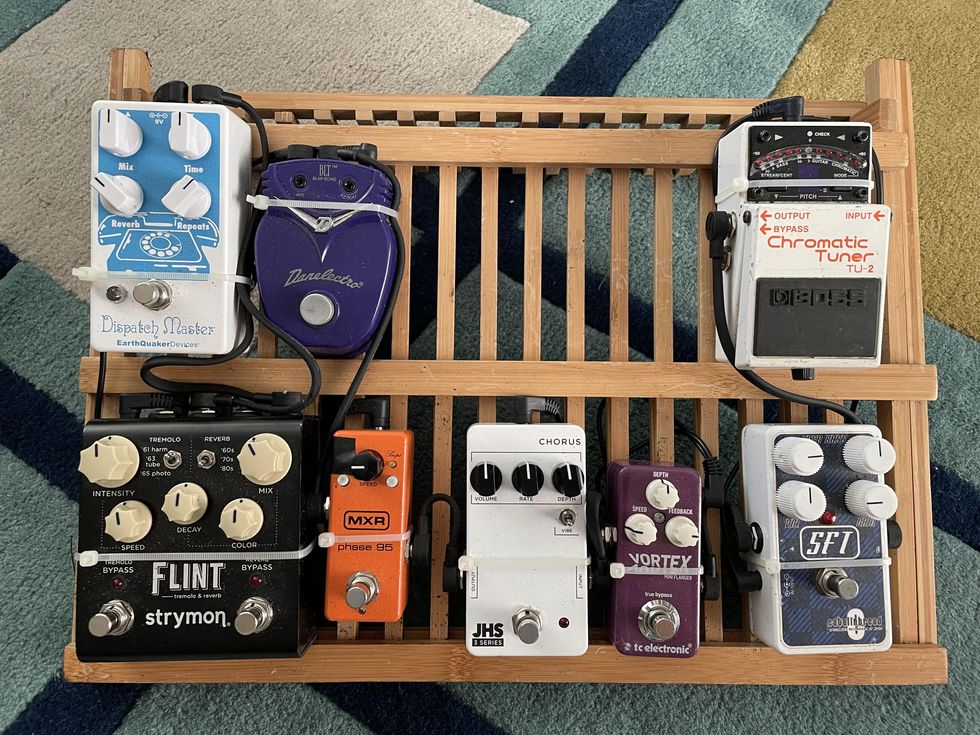
My name is DeMatt Harkins and I live in Jackson, Mississippi. I made my pedalboard out of a wooden dish rack from Target.
Signal Path:
- Guitar ->
- Boss TU-2 Chromatic Tuner ->
- Catalinbread SFT Overdrive ->
- TC Electronic Vortex Mini Flanger ->
- JHS 3 Series Chorus ->
- MXR Phase 95 ->
- Danelectro BLT Slap Echo ->
- Strymon Flint Tremolo & Reverb ->
- EarthQuaker Devices Dispatch Master
Thanks very much!
Jack Thompson: The Alan Parsons Project
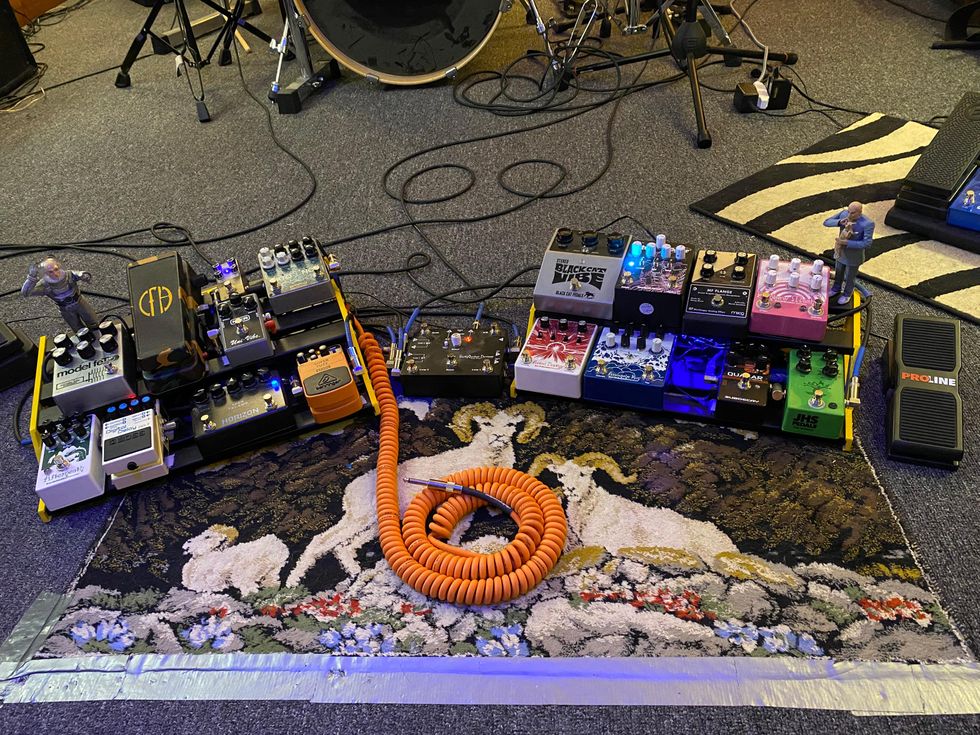
I’m a musician based out of the Twin Cities, Minnesota, and I saw that you were taking pedalboard submissions! So, here’s mine. I’ve been refining and building this in a variety of ways the last seven years. I hope you enjoy and get a laugh.
High Level Overview:
The board consists of two loops (two different boards) controlled via EarthQuaker Devices Swiss Things. This sends the signal to a Mesa/Boogie Mini Rectifier 25 and Fender Hot Rod Deluxe III. The left board is pre-loop, and loop 1 (distortion based) with Dr. Evil in a moonsuit holding Austin Powers’ mojo. The right board is loop 2 (modulation based) with Dr. Evil holding Mr. Bigglesworth. My guitar cable is an orange Divine Noise Curly Cable, purchased from Chicago Music Exchange.
Pedalboard 1 (left):
- Pre-loop section:
- Guitar goes straight into an Emma Electronic Okto Nøjs.
- Then to a Pigtronix Philosopher’s Tone Germanium Gold Micro (this is an “always on” pedal).
- Next is the Dunlop Dimebag Cry Baby from Hell Wah.
- And then finally a MXR Uni-Vibe set at minimal settings (this is typically an “always on” pedal).
Loop 1 (via EarthQuaker Swiss Things):
- Behringer SF300 Super Fuzz
- Horizon Devices Apex Preamp
- Electronic Audio Experiments Model feT
- Boss DD-7 Digital Delay
- EarthQuaker Devices Afterneath V2
Pedalboard 2 (right):
Loop 2 (via EQD Swiss Things):
- JHS Bonsai (minimal drive settings, “always on”)
- Subdecay Quasar Phaser
- EarthQuaker Devices Rainbow Machine
- Moog MF Flange
- Dwarfcraft Devices Witch Shifter
- Black Cat Pedals Black Cat Vibe (Proline expression pedal on the far right is hooked up to it)
- EarthQuaker Devices Avalanche Run
- EarthQuaker Devices Astral Destiny
And that’s it! I’m fortunate to play with some of my best friends in a band called the Electric Honeycomb. Blessings to all of you.
Joe Grant Jr: Satisfying Symmetry
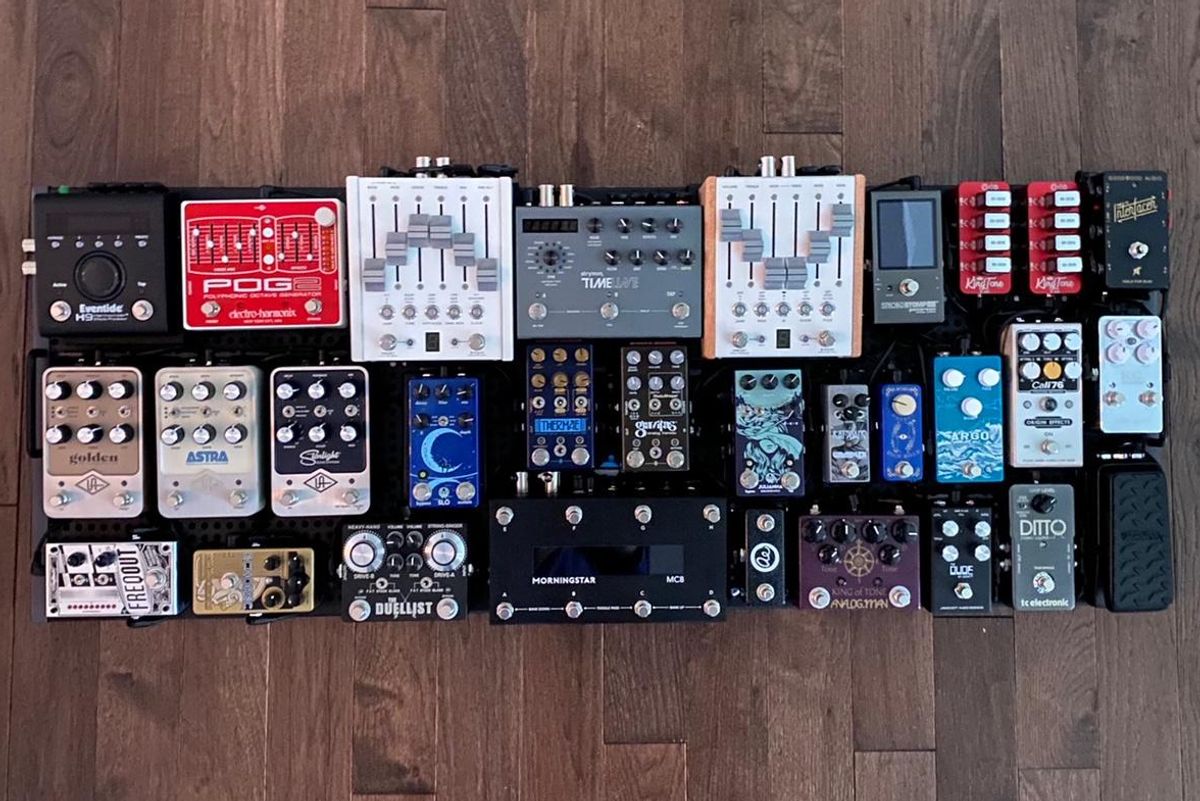
My pedalboard is a Temple Audio TRIO 43 Templeboard. All cables—patch, power, and MIDI—are hand-soldered. I have USB ports on the side to update firmware and program MIDI.
Underneath the pedalboard:
- Strymon Zuma
- Strymon Ojais (2)
- Voodoo Lab Control Switchers (2)
- Goodwood Audio Audition
On top:
- Goodwood Audio The TX Interfacer
- Kingtone Battery Box (2)
- Xotic RC Booster
- Dunlop Volume
- Origin Effects Cali76
- TC Electronic Ditto Stereo Looper
- Mythos Argo Octave Fuzz
- Peterson StroboStomp Tuner
- Mythos High Road Fuzz
- Wampler Ratsbane
- J. Rockett The Dude
- Analog Man King of Tone
- Walrus Audio Julianna
- Chase Bliss Automatone Preamp MKII
- Strymon TimeLine
- Chase Bliss Gravitas
- Chase Bliss Thermae
- King Tone The Duellist
- Walrus Audio Slö
- Chase Bliss CXM 1978
- Electro-Harmonix POG2
- Eventide H9 Max
- Universal Audio Golden Reverberator
- Universal Audio Astra
- Universal Audio Starlight
- DigiTech FreqOut
- Catalinbread Echorec
- Morningstar MC8 Midi Controller
Malcolm Carmichael: Like Angels Singing
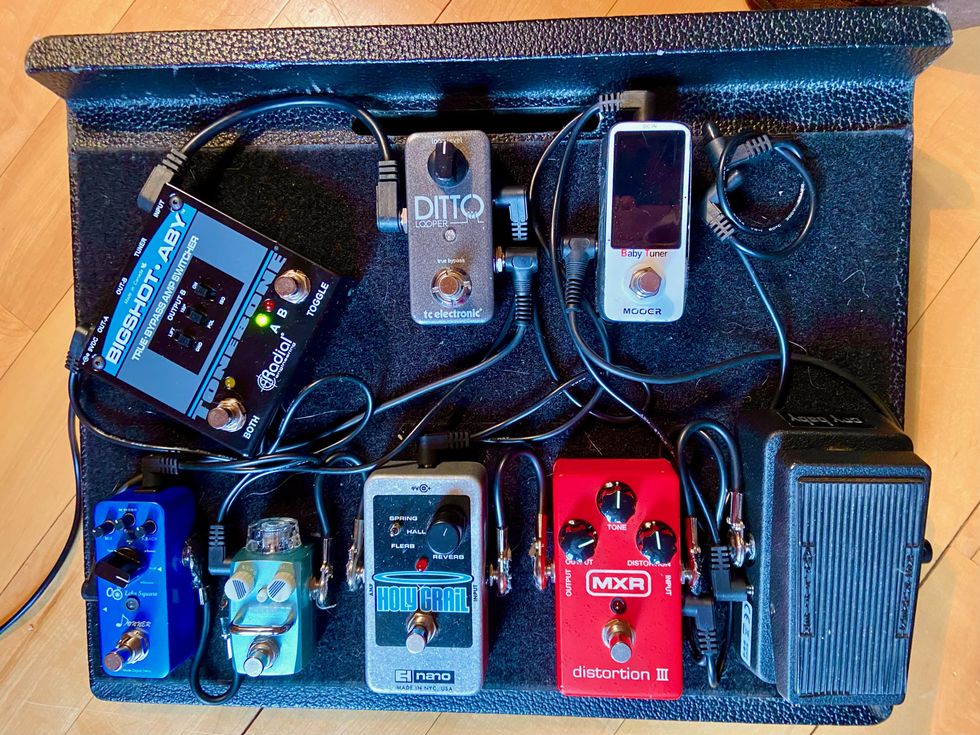
So many pedals, so little time. I don’t think there’s one pedal I haven’t tried out at some point in time but now I just keep it as simple as possible to have everything I need for the setlist my band plays. Also, I’m terrible with patches and programming. All of these are powered just by a simple Power-All 9V/2A wall wart. I’ve tried lots of power supplies and this is light and reliable.
First, the Mooer Baby Tuner is very simple, works every time. Next, is the Dunlop Cry Baby Mini Wah. I’m the rhythm player in my band, but there are a couple tunes where I solo, and I use this when I’m just winging it. It helps and makes me sound better than I am! I think all distortion pedals are a trade-off, but the MXR Distortion III is as good as any and it’s tried and trusted.
Then we have the Electro-Harmonix Holy Grail Nano. Everybody needs a Holy Grail! I’m always surprised how many pro pedalboards I see it on. Very versatile pedal and easy to use. Next is the Hotone Eko delay: I go through all sorts of these little pedals. I find them in bargain bins. This delay is perfectly fine with all the adjustment you need. The Donner Echo Square is a little gem. It’s got everything, including a reverse, which is what I use it for on an original song we play, but it’s got a lot of other great options as well. I like the TC Electronic Stereo Ditto Looper because it’s so simple.
Lastly, I have one of the best ABY switchers in the game, the Radial BigShot. With this, I send out into a Fender Blues Deluxe Reissue and a Vox AC15. Together they are like angels singing. All we have to do now is get this craziness behind us so we can get gigging again. Cheers!
Matt Straw: The Blackboard
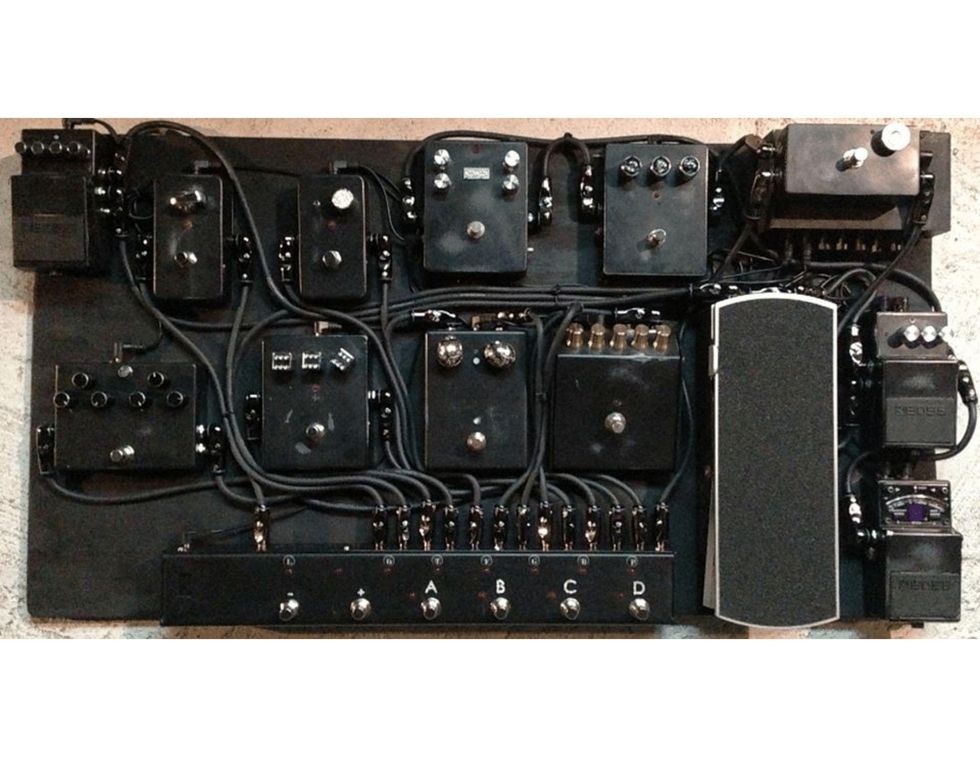
I saw the all-white pedalboard from last year’s reader pedalboards, and it reminded me of my black one. My pedalboard(s) are constantly in a state of evolution: I’ve since ditched most of these and gone back to basics. I was using this board from 2014-2016 back when I lived in Nashville and was in the band Things That Crawl. I’ve always hated branding of any type, and I found the varied colors and designs kinda messy and a distraction.
I’m also a professional guitar tech (Robert Plant, Bonnie Raitt, Jack White, Shania Twain, etc.) and am used to fans trying to sneak a peek at the pedals onstage, so I liked the idea of keeping a bit of mystery there (not that anyone could care less about what I was using).
Here’s the list of pedals:
- Boss Tuner
- Boss NS-2 Noise Suppressor
- Ernie Ball Volume Pedal
- ZVEX Super Hard On
- Electro-Harmonix POG
- Tech 21 NYC SansAmp
- Electro-Harmonix Bassballs
- Electro-Harmonix LPB-1
- Boss DD-7 Digital Delay
- Red Witch Medusa Chorus Tremolo
- Electro-Harmonix POG2
- MXR Classic 108 Fuzz
- Marshall The Guv’nor
I eventually added two EarthQuaker Devices pedals (Organizer and Talons), plus a TC Electronic Alter Ego and an MXR Ten Band EQ.
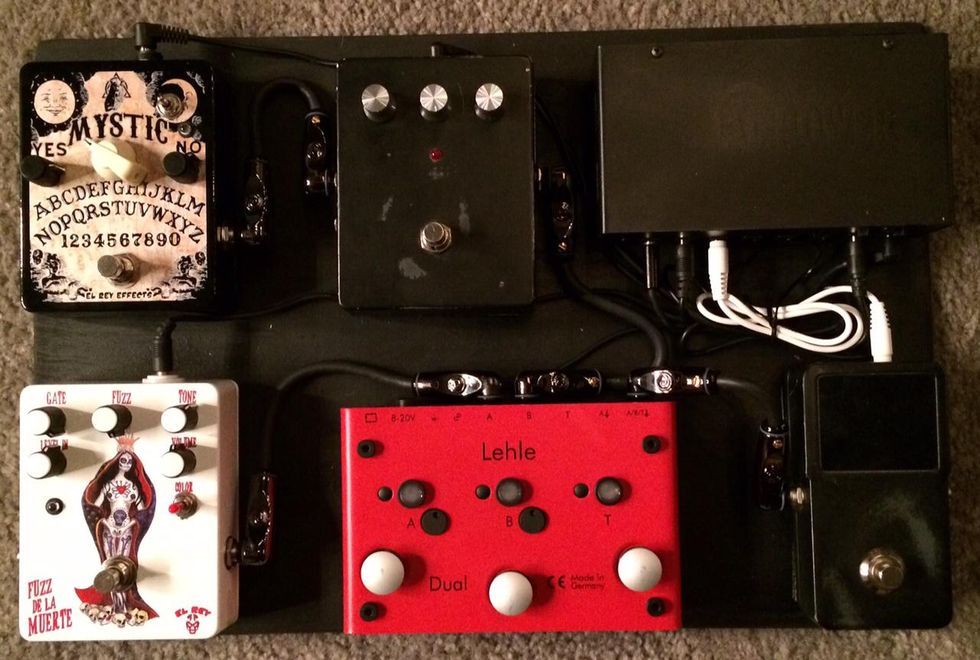
In 2016, I formed a short-lived band called Buffalo (before moving to Joshua Tree) and built a totally new pedalboard with the El Rey Mystic Fuzz, El Rey Fuzz De La Muerte, Electro-Harmonix POG, TC Electronic PolyTune, and a Lehle Dual. Both the El Rey pedals remain unpainted as I think they look super cool! Enjoy.
Nedim Kirlic: Streamlining in Sweden
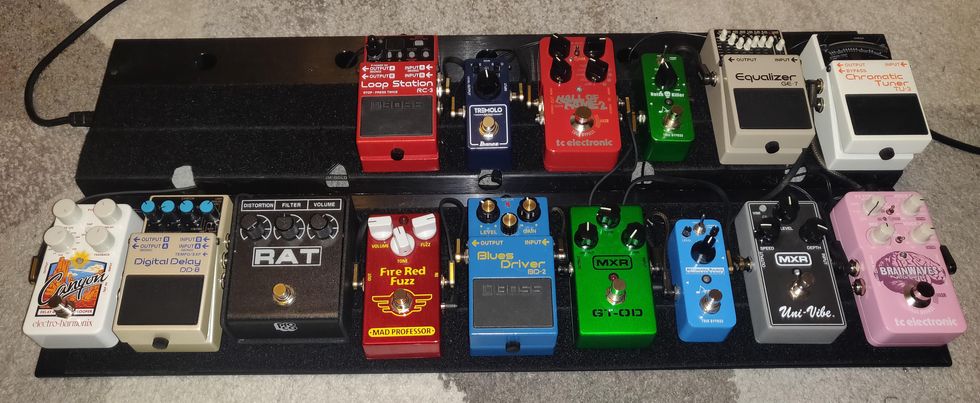
I’m a guitarist in Sweden. As a 40-year-old, I decided to build my first pedalboard because I wanted to simplify my rig and give myself fewer options than there are in my Line 6 modeler products. Having said that, I quickly realized that it’s not as simple as just putting a few pedals on there. I wanted a pedalboard with a simple pitch shifter-overdrive-distortion-chorus-delay-reverb setup. But it turns out I needed four utility pedals, and more than one overdrive. I was never into fuzz, but I decided to go for it.
The board right now consists of the list below, with the signal chain in order. Though the Boss delay will probably be moved early in the chain, along with a second reverb that I haven’t gotten yet.
- T-Rex pedalboard, 70 cm wide
- T-Rex Fuel Tank Chameleon isolated power supply, mounted underneath with a rail (two pieces)
- Boss TU-2 Chromatic Tuner
- TC Electronic Brainwaves Pitch Shifter
- MXR Uni-Vibe
- Boss GE-7 Graphic Equalizer
- Donner Noise Killer Noise Gate
- Donner Ultimate Comp Compressor
- MXR GT-OD Overdrive
- Boss BD-2 Blues Driver
- Mad Professor Fire Red Fuzz
- ProCo RAT
- Boss DD-8 Digital Delay
- Electro-Harmonix Canyon Delay & Looper
- TC Electronic Hall of Fame 2 Reverb
- Ibanez Tremolo Mini
- Boss RC-3 Loop Station
- The empty spot is reserved for a Boss IR-200 Amp & IR Cabinet
The signal chain right now is going straight into the front of the amp, but sometimes I use the FX loop. In that case, I put the delay, reverb, and tremolo pedals into the loop. And lastly, the loop pedal is last in my signal chain for trying out quick ideas: I record a riff, loop it, and see what bass notes and what sort of bass line I’m going to play over it. The bass line makes a huge impact on the idea and on the finished song.
Ronald Caminati: Aesthetically Pleasing
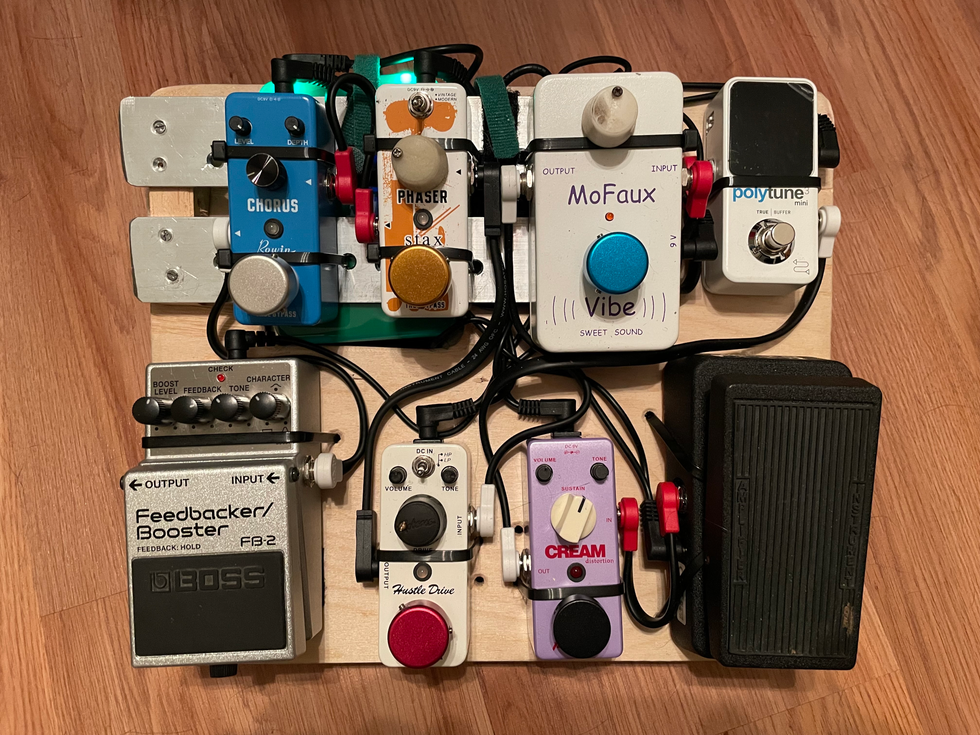
Here’s my list of pedals: Dunlop Cry Baby Mini Wah, TC Electronic PolyTune3 Mini, Sweet Sound MoFaux Vibe, Toms’line Cream Distortion, Stax Phaser, Mooer Hustle Drive, Rowin Chorus, and finished off by a Boss FB-2 Feedbacker Booster. All powered by a Pedaltrain Volto.
Steve Kellett: The Family Tree
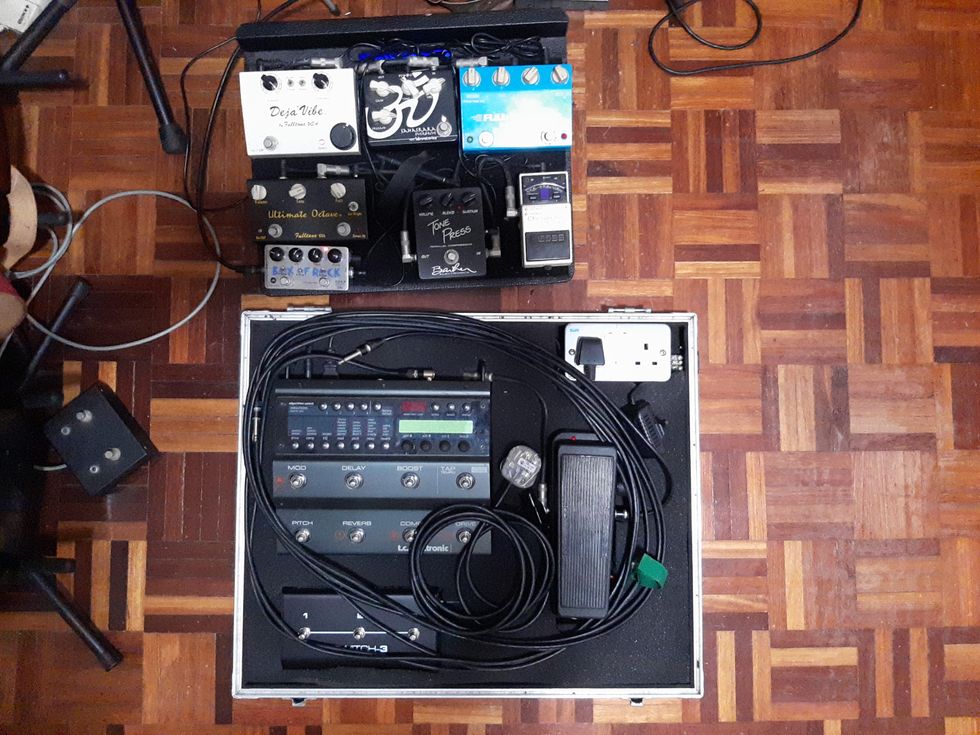
I recently decided to take a family portrait of my pedalboards. I had to take two photos to get it all covered! Spoiler Alert: I have 12 pedalboards.
In the first image, there’s a custom-built flight case containing a TC Electronic Nova System plus extension footswitch and a Dunlop Mister Cry Baby Super Volume/Wah.
Pictured above that, is a Gator Pedal Tote board with the following on it:
- Boss TU-2 ->
- Barber Tone Press ->
- Fulltone Ultimate Octave ->
- Fulltone Full-Drive 2 FM ->
- Om Labs Sahasrara Overdrive ->
- Fulltone Mini-Deja’Vibe ->
- ZVEX Box of Rock Vexter
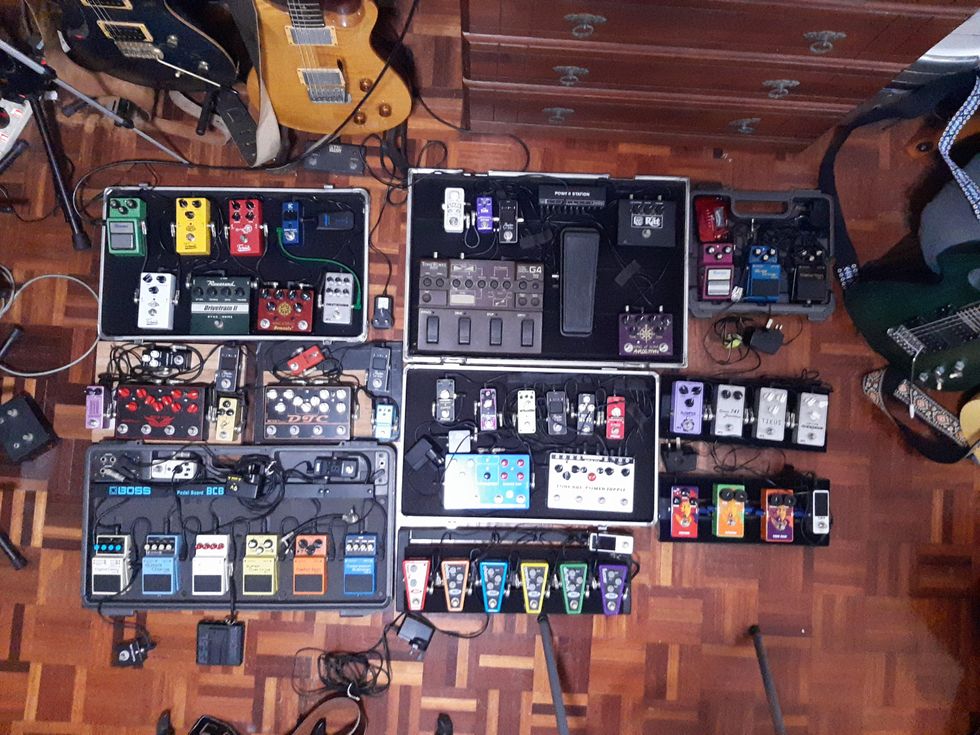
(Just to prove that nothing is permanent in the pedal world, the Sahasrara has since been replaced by a Fulltone GT500.)
The second photo (do I really have to do this?) ... DEEP BREATH.
Top row from top left we have my Leftovers Board:
- A beat-up CNB case containing a cheapo tuner
- XFX Boutique Destroyer (Friedman BE-OD clone)
- DemonFX King of Drive (clone of a guess what)
- Twinote Pi Fuzz
- Reverend Drivetrain II
- Twinote BBD Chorus
- Twinote BBD Delay
- Ibanez TS-9 RI
Moving clockwise to the right is my Workhorse Board 1:
- Cry Baby Wah
- LY-Rock King of Tone clone
- ProCo Vintage RAT
- Korg G4
- Rowin tuner
- Ammoon Nano Delay
- TC Electronic Spark Mini Booster
Next, to the right, Grab and Go Board 1:
- Boss BCB-30 board
- Boss DS-1 40th Anniversary Edition (which I won from PG’s Stomboxtober giveaway in 2018)
- Keeley-modded Boss BD-2
- ’80s Ibanez AD9
- Fender in-line tuner that gets used when required
Moving on to the second row and starting on the very left is my Chopping Board 1:
- Rowin tuner
- Muslady Golden Horse (Klon Klone)
- Mosky Red Fox (Timmy-based overdrive, CE-2-based chorus, and a delay; FX loop between overdrive and chorus)
- Mosky Black Rat in the FX loop
- Mosky Spring Reverb
Moving to the right is Chopping Board 2 (Yes, they really are bamboo chopping boards that fit into laptop slip cases):
- Rowin tuner
- Rowin Frenzy fuzz
- Mosky DTC (Suhr Riot-based distortion, TS-9-based overdrive; FX loop, and delay)
- Rowin Nano Phaser in the FX loop
Poor Person’s Pink Flow Board:
- Ghost Fire case
- Tomsline AGF-3 G-Fuzz (Germanium Fuzz Face clone)
- Mosky Mini Muff
- Rowin Tuner
- Mosky Tone Bus (Dyna Comp, TS-9, and OCD clones plus power supply for the board)
- Tom’sline AMS-3 Mod Station
- Mosky Tone Makestation (Plexi distortion, FX loop, EP booster, and delay)
- Mastersound Flanger in the FX loop
- Tom’sline ASR-3 Shaper (cab sim)
- Mosky Mini Clean Buffer
Grab and Go Board 2:
- Ammoon pedalboard (containing all XFX Boutique pedals)
- Nine O Nine (TS-based low-gain overdrive)
- Tikus (RAT clone)
- Classic 741 Distortion (MXR Distortion+ clone)
- Slowpick Analog Delay
Bottom row from left to right:
Workhorse Board 2:
- Boss BCB-60 board
- Korg Pitchblack Mini Tuner
- Boss CS-3 Compression Sustainer
- Keeley DS-1 Ultra Mod
- Keeley SD-1 Overdrive
- Boss JB-2 Angry Driver
- Orange FS-1L
- Boss CH-1 Super Chorus
- Boss DD-8 Digital Delay with Mosky tap tempo
- Mooer Pure Boost
The Cheese Board:
- Pedaltrain Mini
- cheapo tuner
- 6 ModTone Mini-Mod pedals (Fuzz, Distortion, Overdrive, Chorus, Delay, and Boost)
The Hendrix Board:
- Ammoon pedalboard
- Dunlop Hendrix 70th Anniversary Fuzz Face
- Hendrix Octavio
- Hendrix Univibe
Whew! And that concludes my family tree of pedalboards. Strewth!
Taylor Schlupp: Tom Bukovac Inspo
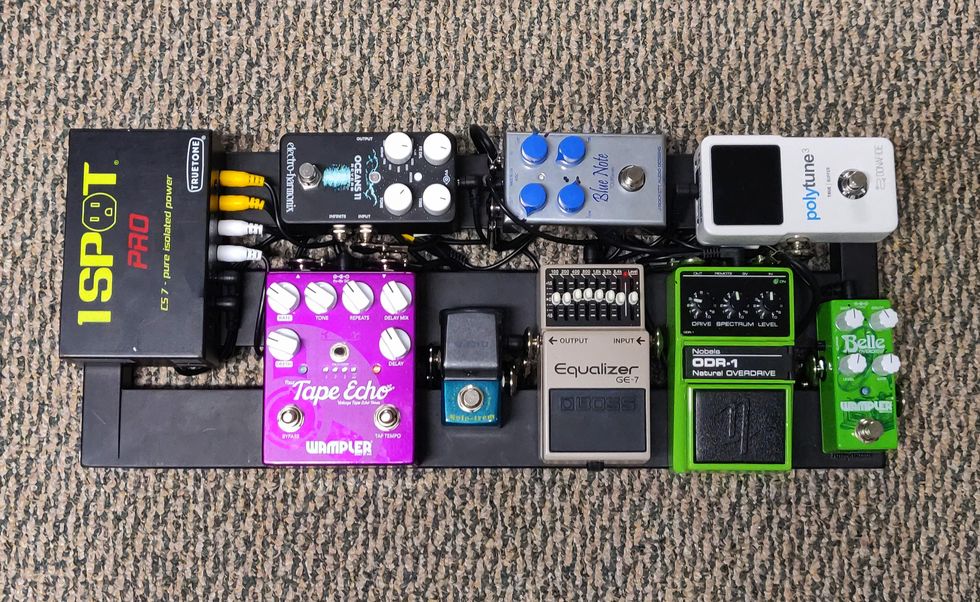
Hey guys! Here’s a pic of my studio board that I use for recording music and YouTube videos. It’s got a bit of Tom Bukovac inspiration here after seeing his Rig Rundown lol.
Signal Chain:
- TC Electronic PolyTune
- J. Rockett Blue Note Overdrive (always on)
- Wampler Belle Overdrive
- Nobels ODR1 Natural Overdrive
- Boss GE-7 EQ
- Joyo Ironman Molo-Trem
- Wampler Faux Tape Echo
- Electro-Harmonix Oceans 11 Reverb
- Truetone 1 Spot Pro CS7 Power Supply
Tom Foreman: Tone Hunters
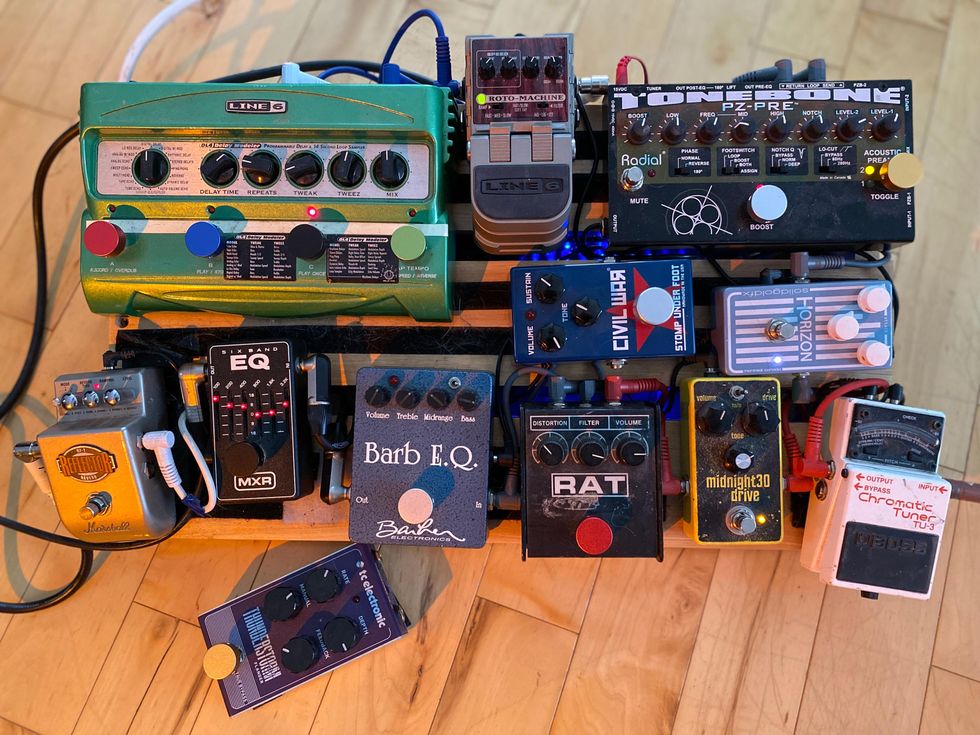
Hi Folks,
I hope all is well with each of you. I look forward to seeing the issue with these photos because it’s always nice to hunt for ideas. I made the pedalboard out of some hardwood sugar maple wood bits left over from a “music-lesson-for-lumber” trade I did with a local forester. It is roadworthy and weighs a ton (just in case I ever need to stun a drummer with it, I suppose).
This board serves a dual purpose with supporting my acoustics and electrics. For acoustic, I run a 1963 Gibson J-50 and a Crafter D6/N through the Radial Tonebone PZ-Pre Preamp with a SolidGold FX Horizon Compressor in the effects loop.
For the electric side, I run a Gibson ES-339 or my Tele into the following:
- Boss TU-3 Chromatic Tuner
- Midnight 30 Music Upstate Drive (Always on, always awesome! Josh Eiler makes some absolutely killer gear, and this pedal was one of the earlier ones.)
- Late 1980s Pro Co RAT (I got it from Not Just Another Music Shop in Vancouver, BC, while on tour sometime in the early ’90s ... I think)
- Stomp Under Foot Civil War Fuzz (sometimes it sits in for the RAT)
- Barber Electronics Barb E.Q. (boost, grit, chime)
- MXR Six Band EQ (for when I blow a string on my 339 and have to shift over to the Tele mid song)
The effect-loop chain includes: a Line 6 Roto-Machine or TC Electronic Thunderstorm Flanger, a Line 6 DL4, and a Marshall RF-1 Reflector Reverb.
Everything goes into a Dr. Z MAZ 18 NR and a Port City Waves 2x12 cab that I think has one vintage Greenback and one WGS Veteran 30 speaker, but I haven’t looked under the hood in a long time so who knows? Love the magazine and I look forward to it showing up each month!
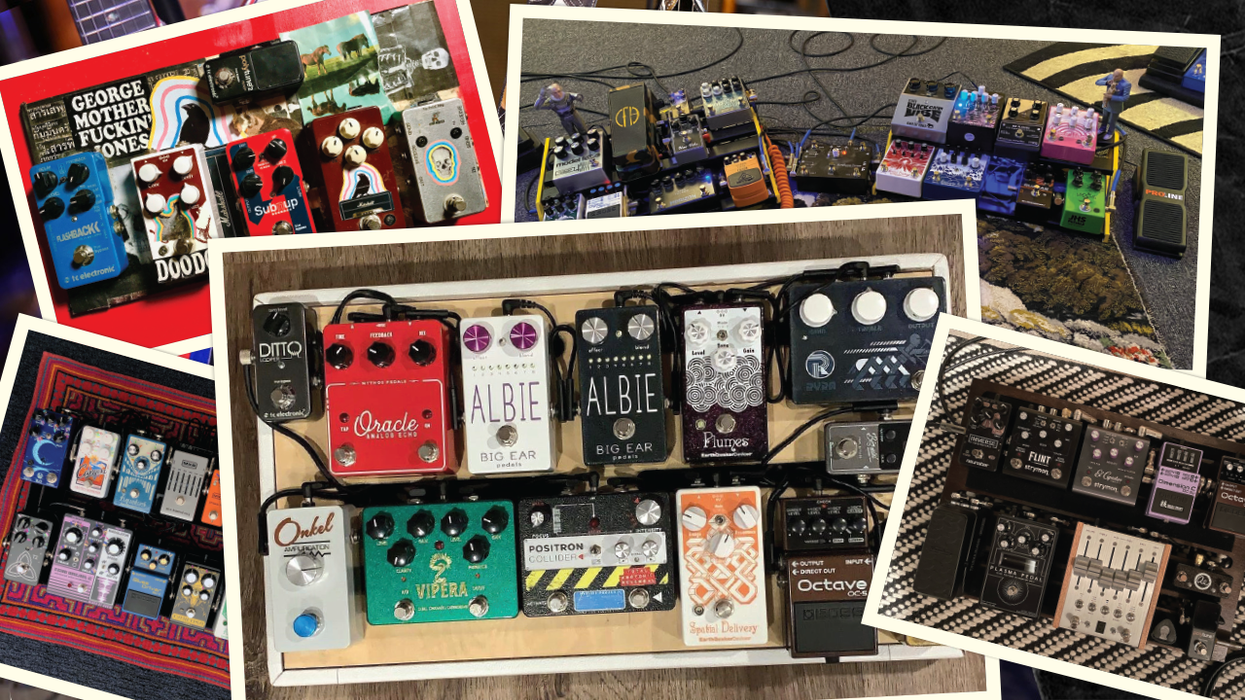
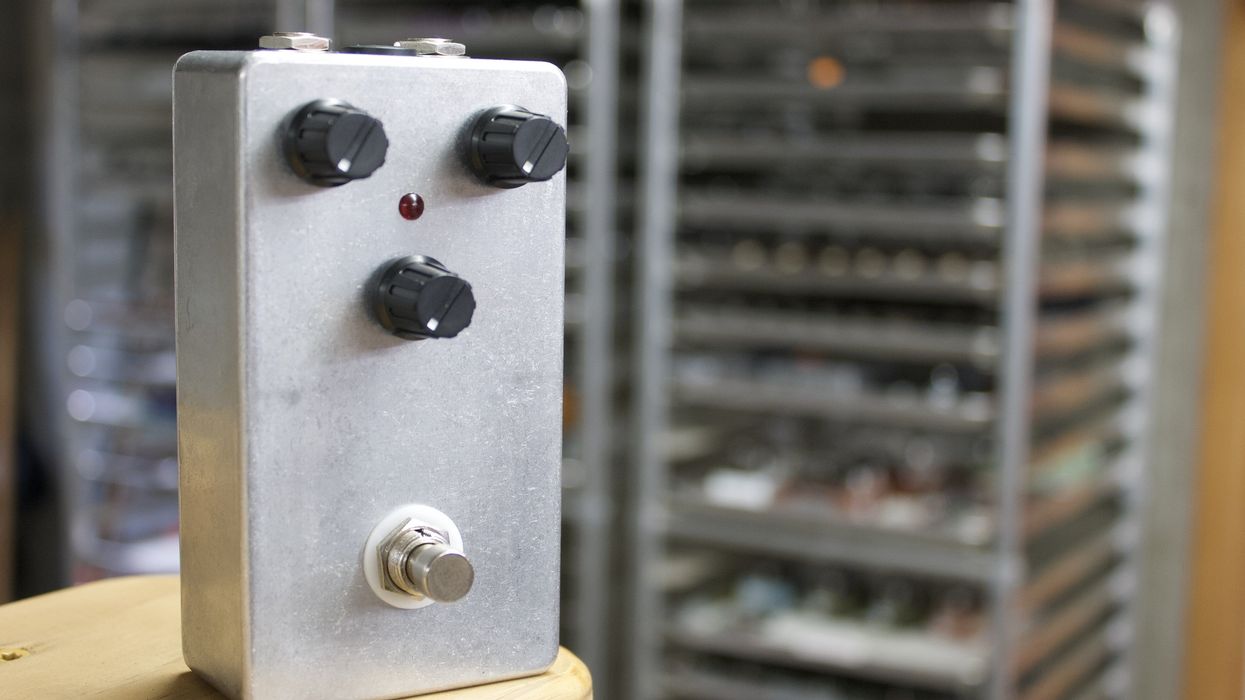
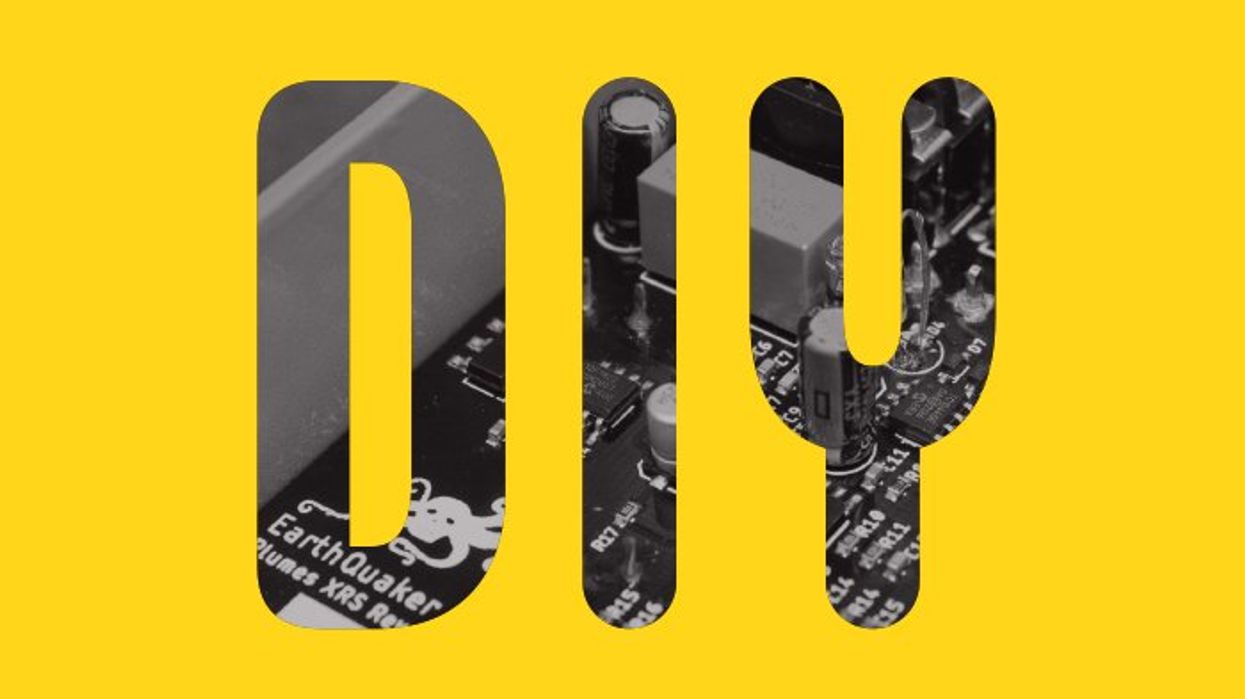
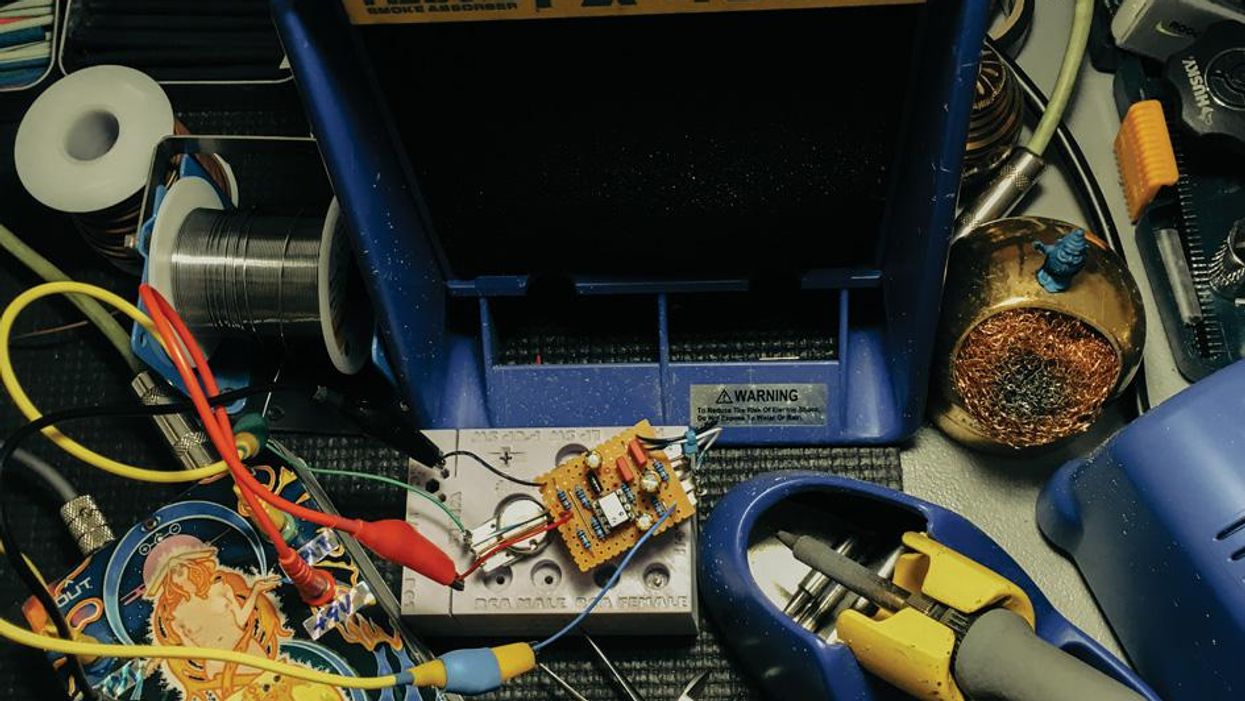
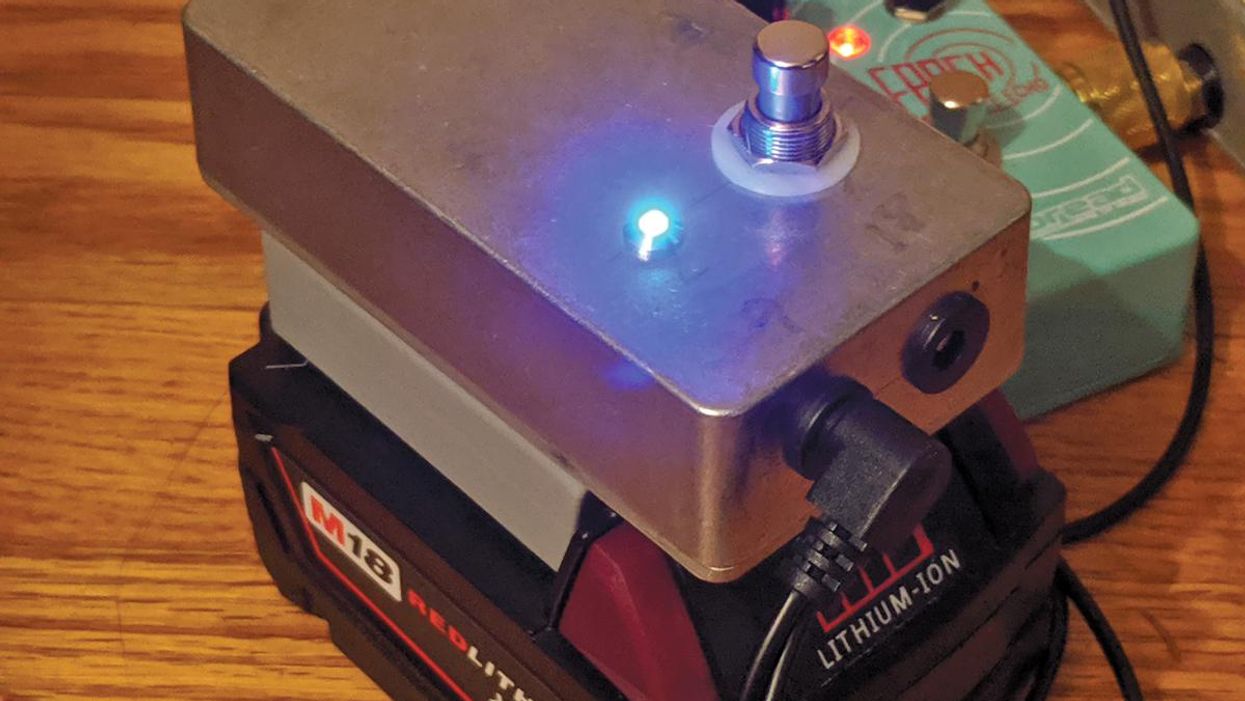
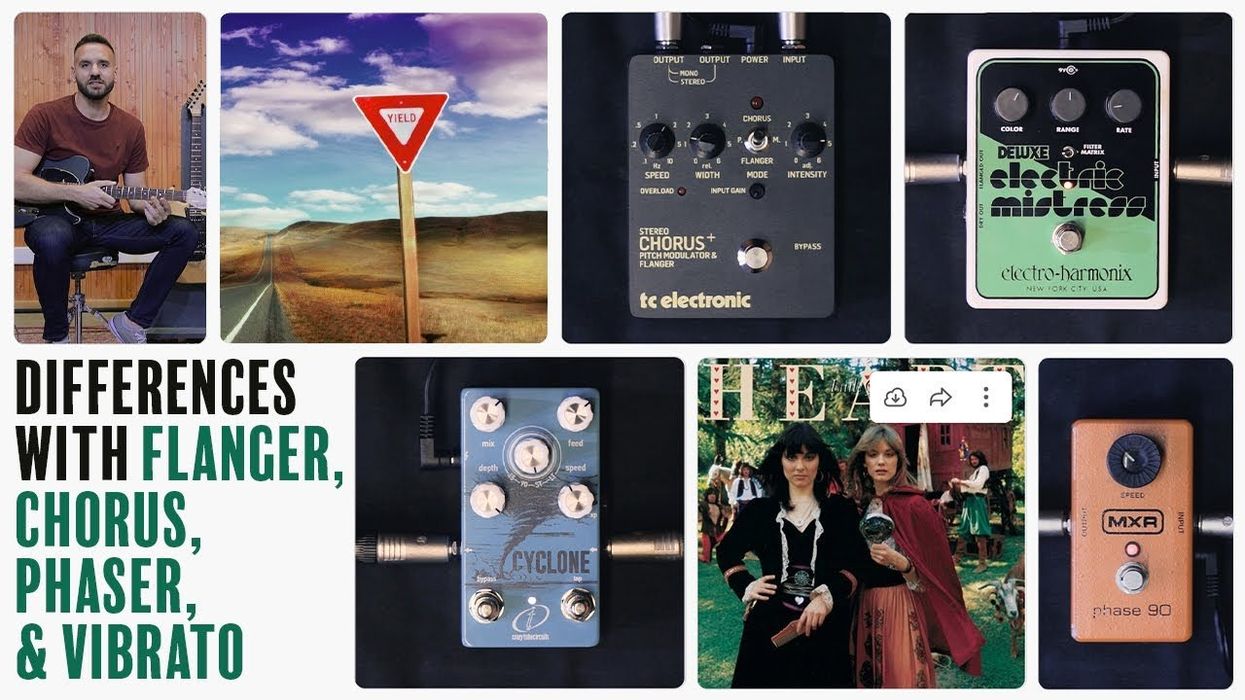
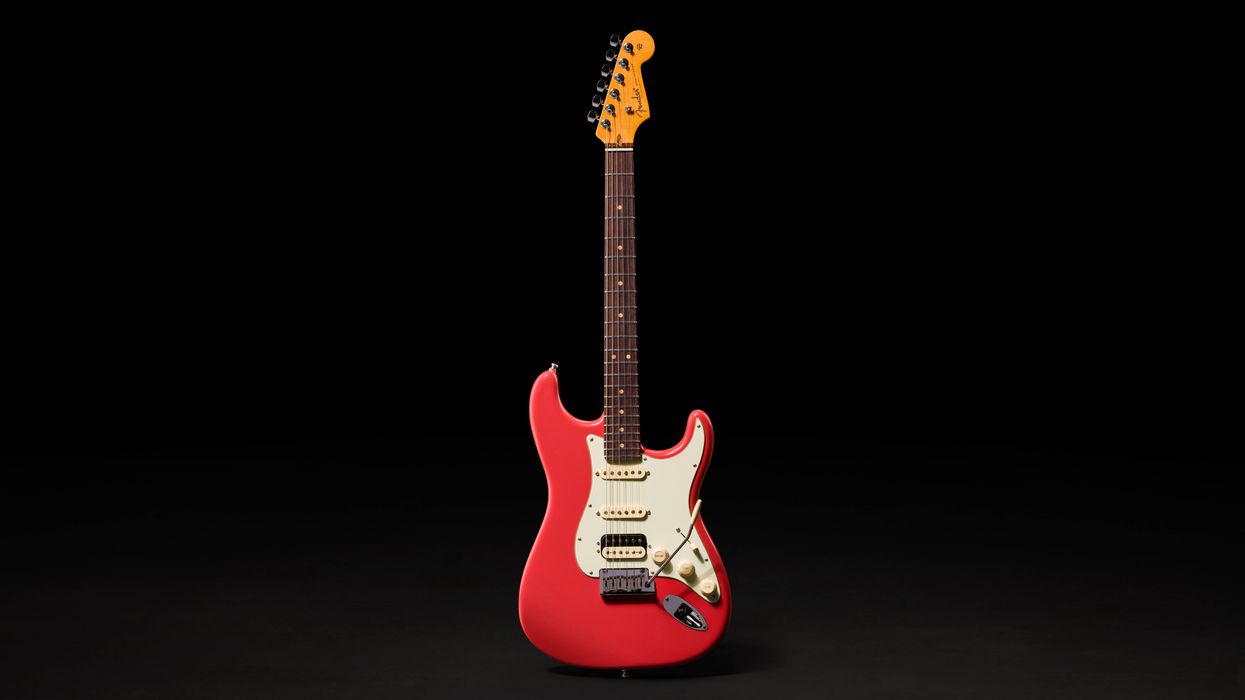
![Rig Rundown: AFI [2025]](https://www.premierguitar.com/media-library/youtube.jpg?id=62064741&width=1245&height=700&quality=70&coordinates=0%2C0%2C0%2C0)
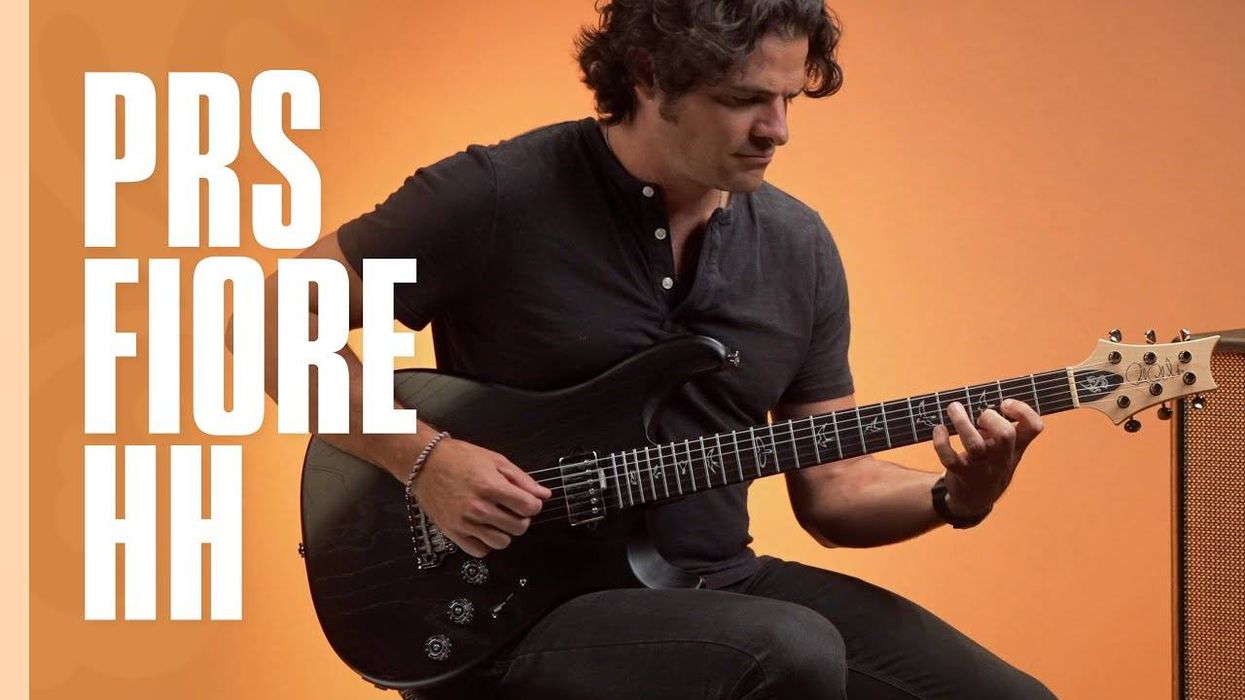

![Devon Eisenbarger [Katy Perry] Rig Rundown](https://www.premierguitar.com/media-library/youtube.jpg?id=61774583&width=1245&height=700&quality=70&coordinates=0%2C0%2C0%2C0)

